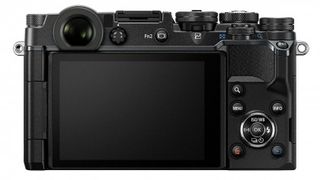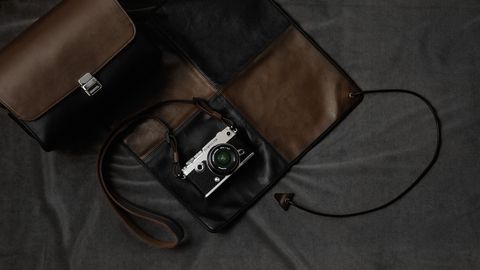Why you can trust TechRadar
Rather than adopting the SLR styling of the OM-D series, Olympus has stuck with the more rectangular shape of the PEN series and gone for a more rangefinder style for the PEN-F. Consequently the viewfinder is in the top left corner of the camera as you hold it for use – as with the Fuji X-E2S and X-Pro2.
The PEN-F's retro design isn't limited to its appearance, it also has the type of build that makes photographers smile and get a bit misty-eyed when they pick it up – solid and made from metal. The milled metal dials speak of quality, each feeling good under your finger, rotating smoothly and clicking satisfyingly into position. The buttons on the back of the camera, however, are a bit more run-of-the-mill, adopting the rather small, plastic form that draws some criticism of the Olympus PEN and OM-D range. Nevertheless, they do their job and the camera responds quickly to their use.

In keeping with the original 1960s design of the PEN series, there's no grip on the front of the PEN-F. Thankfully there is a small, but very effective thumbgrip on the back, which helps keep the camera steady in your hand. Given the weighty density of the PEN-F I attached a wrist strap (a Peak Design Cuff, to be specific) to keep it safe during this test. It didn't actually slip out of my grasp at any point, but I felt the need for a little extra security.
On the front of the camera is a distinctive new Creative Dial which gives a route to the Art Filters and Color Creator (to specify saturation and color cast) as well as the new Monochrome Profile Control and Colour Profile Control. The Monochrome Profile Control enables one of eight black and white filter effects to be applied at three different strengths. Meanwhile, the Colour Profile options gives a bit more control than the Color Creator (CRT) and allows the saturation of 12 colours to be adjusted individually or together across 11 steps (-5 to +5).

Once the desired settings have selected for each of the Creative Dial modes, rotating the dial switches the camera to that option. It provides a quick means of shooting JPEGs with different effects applied and can be used in conjunction with the sprung switch/dial that gives a route to the Shadow and Highlight control, so if you want to use the Pin Hole II Art Filter, then switch to shooting low saturation, high contrast colour images and then monochrome images with a red filter effect, for example, you can.
When the Creative Dial is in the 'neutral' position JPEGs are saved with the selected Picture Mode (I-Enhance, Vivid, Natural etc). Whatever position the dial is in, the desired creative option can be set either via the Super Control Panel activated by pressing the OK button or the main menu. While it's great to have plenty of flexibility, there are so many opportunities to customise the appearance of JPEG images it can be confusing at first.
On the top-plate there's another new dial for an Olympus camera, an exposure compensation dial offering settings in the range -/+3EV. It's conveniently placed for making adjustments with your thumb when looking through the viewfinder and has enough tension to not rotate accidentally on a frequent basis.

There are still some photographers that remain to be convinced about electronic viewfinders, but they have improved a lot over the last couple of years or so. The 2.36 million dot unit in the PEN-F is very good, showing lots of detail in most shooting situations. It also has a high refresh rate so you can pan with moving subjects without having to guess where the target is. In very low light there's a little noise visible, but the image is generally very clear. On the rare occasions that you need to focus manually the automatic magnification and focus peaking options, which can be set to activate via the menu, are useful but you should expect to see more obvious noise in low light.
When the EVF Auto Luminance option was turned on in the menu, I found that the viewfinder sometimes showed scene as a little brighter than the recorded image which tricked me into underexposing. I recommend setting the EVF brightness manually.
The sensor next to the viewfinder is helpful, detecting when the camera is held to the eye and activating the EVF while turning off the screen. However, the sensor doesn't operate when the screen is out to the side of the camera and you have to switch manually by pressing the Fn2 button which by default is dedicated to the job.
The 3-inch, 1,037,000-dot LCD on the back of the camera is also very good, responding quickly to a touch and displaying lots of detail. Once again it's a shame that it's not possible to make main menu selections and adjustments using touch control, but it is possible with the Super Control Panel.
When the AF Targeting Pad option is set to 'On' in the menu you can set the active AF point by dragging a finger or thumb around the screen. Left eye users need to beware of setting the AF point with their nose. Unfortunately it's not possible to set the AF point via the screen when the screen is swung out to the side of the camera.
On the whole the PEN-F is enjoyable to use but it has some of the quirks that we've seen with other Olympus cameras. For example, it's sometimes necessary to turn the camera of and on again to get the electronic level to activate when the appropriate button is pressed.

